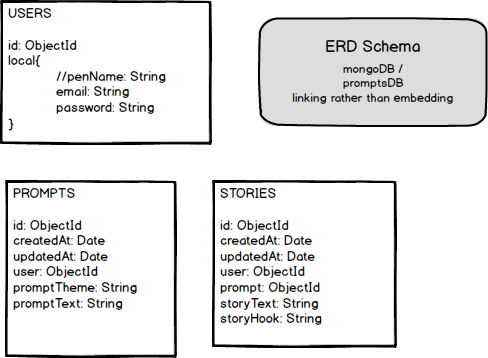A simple kick-the-tires sample web application that demostrates use of NodeJS, ExpressJS and MongoDB built in one 5-day week as our team-based project 3 for WDI students at General Assembly ~ Atlanta in May 2016.
The sample app is a Create Writing site, where a user can find or write a writing Prompt, and then write a Story from the Prompt, while securely used CRUD (Create, Read, Update, and Delete) operations because of the Authentication and Authorization features from Passport, authentication middleware for Node.js.
STEPS for Installing
git clone URL- Issue the CD command into the directory
npm installnodemon start- and launch your browser to http://localhost:3000/
The live app lives over on our production Heroku server at:
TODO: Write better usage instructions
With the browser window open, navigate to the homepage at /
The user can sign-up, log-in, create a prompt and then write a story and log-out.
We wrote lots of sample routes, and tried embedding stories in prompts and prompts in users, much like a sample ToDo app might, but found we needed to Link, rather then embed our data. We had lots of samples and false turns to go down in the first 2 days.
1.7.72
This project is licensed under the open-source public-domain WTFPL License.
Our guidelines are;
- Include sign up/log in functionality, with encrypted passwords & an authorization flow (DONE)
- Have complete RESTful routes for at least one of your resources with GET, POST, PUT, PATCH, and DELETE (DONE)
- Have at least 2 models (more if they make sense) – one representing someone using your application, and one that represents the main functional idea for your app (DONE)
- Utilize an ORM to create a database table structure and interact with your relationally-stored data (DONE)
- Include wireframes that you designed during the planning process (DONE)
- Have semantically clean HTML and CSS (DONE)
- Be deployed online and accessible to the public (DONE) https://wdi-writing-prompts.herokuapp.com/
Our Trello board.
Our Wireframes page.
Our ERD diagram
Link to User Stories Readme file
###Models
- User Model
- Prompt Model
- Story Model
###Features
- Log in/Log out (DONE)
- Authentication (DONE)
- Authorization (DONE)
- View Home without logging in (DONE)
- Full CRUD with hidden editing
###Technologies
- Git and GitHub source control system (steps we use as a team)
- Heroku production server
- HTML5
- CSS3
- bootstrap
- bootswatch
- font-awesome
- Node.JS
- Express.JS
- debug
- morgan
- ejs
- body-parser
- passport
- bcrypt-nodejs
- cookie-parser
- connect-flash
- method-override
- mongoose
- MongoDB
- A working web application, built by the whole team, hosted somewhere on the internet (DONE)
- A link to your hosted working app in the URL section of your Github repo (DONE)
- A team git repository hosted on Github, with a link to your hosted project, and frequent commits from every team member dating back to the very beginning of the project (DONE)
- A readme.md file with:
- Explanations of the technologies used (DONE)
- A couple paragraphs about the general approach you took (In-Progress)
- Installation instructions for any dependencies (DONE)
- Link to your user stories – who are your users, what do they want, and why? (DONE)
- Link to your wireframes – sketches of major views / interfaces in your application (DONE)
- Descriptions of any unsolved problems or major hurdles your team had to overcome (In-Progress)
- Future vision for the project (In-Progress)
Placeholder for defining our variables
- User and users; gives us
global.currentUser, which in turn gives us access tocurrentUser._idandcurrentUser.local.email - Prompt and prompts; Prompts have
promptThemeandpromptText - Story and stories; Stories have
storyHookandstoryText - All pages have a
myTitle
Things left for other iterative build cycles;
- Create an API (could work well with Prompts as an outward facing publicly accessible API)
- Consume an external API such as pulling a twitter feed, based on the Prompt Theme you chose.
- Add a Twitter feed to different Prompt Theme pages
- Maybe change the background of main container for the Story Hook, based on the Prompt Theme.
Things we could do with another day or two;
- Adding a form to the User, for adding PenName and then using the PenName, instead of just the email, as the users "handle",
- Display the PenName on a displayed Story
- Use the PenName on the displayed Story as the link to the Users Show page, which shows the Prompts and Stories that this person has Created.
